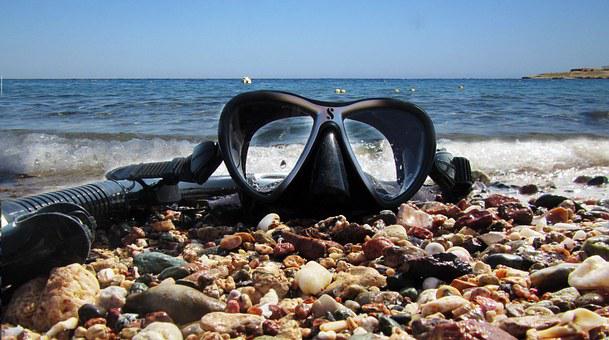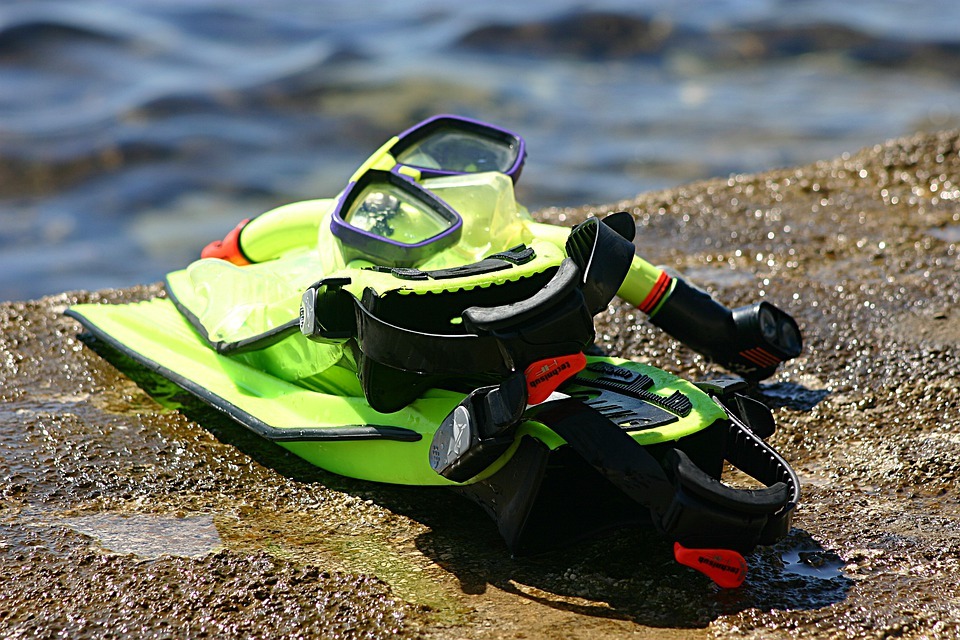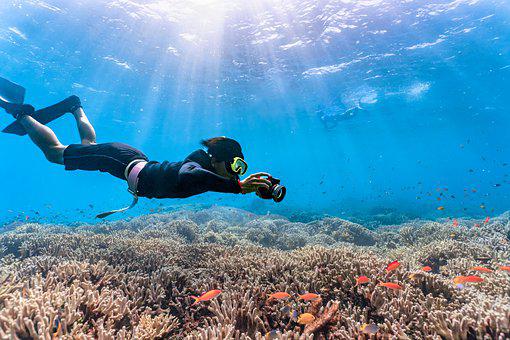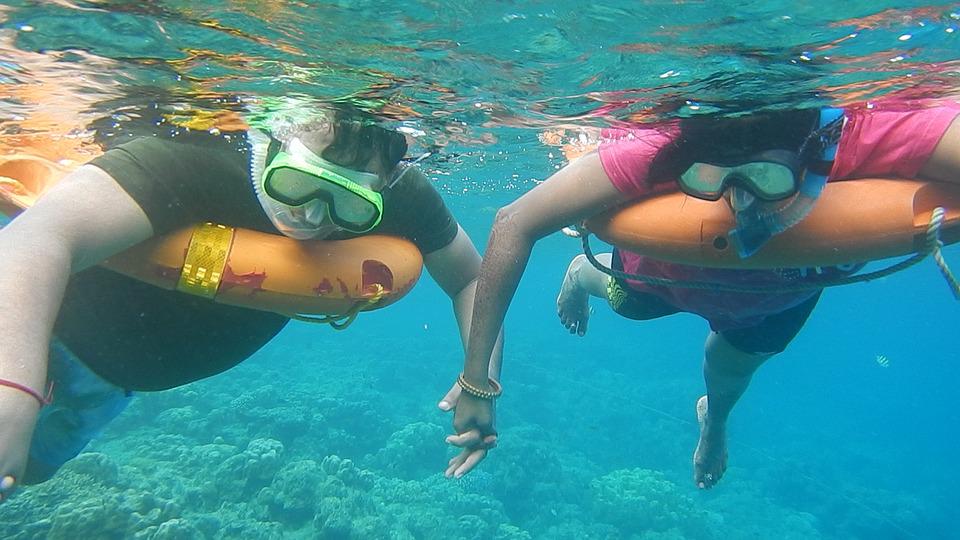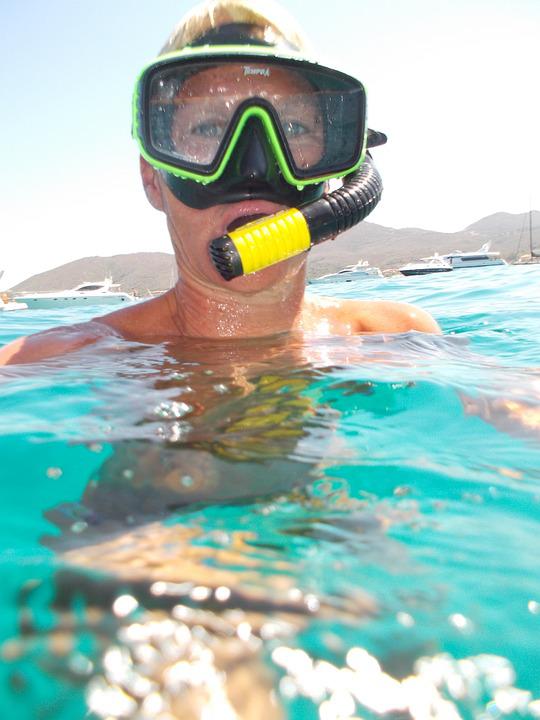When you face down and your mouth is under water, the snorkel is a breathing tube that allows you to breathe air from the surface. It is made up of a tube and a mouthpiece. An intriguing fact is that the first snorkel recorded in history was invented in Greece in 400 AD. Technically, it was a piece of bamboo used for surface swimming breathing. Fortunately, technology has advanced significantly, and various models are now available.
Traditional open-tube versions are still in use and work well for certain types of divers, but because water can easily enter the tube, we recommend using a dry snorkel for a safe and comfortable snorkeling experience.
What Exactly Is a Dry Snorkel?
It is a snorkel with a mechanism that allows very little (or no) water into the snorkel. This includes when you submerge the snorkel by accident or when the snorkel goes underwater while skin diving or scuba diving. If water does get into the snorkel tube, it is channeled out so that it does not interfere with breathing.
So, what are the benefits of using a dry snorkel?
- Absence of Water
Obviously, this is the most significant benefit of these types of snorkels. If they work properly, you should not get a mouthful of water, as with other types of snorkels.
- Conserves energy
The snorkeler should be able to save energy and swim more efficiently with these snorkels. The person will not have to force air out of the tube or raise their head to clear the snorkel. Ideally, it will be one continuous swim.
What about the drawbacks of using a dry snorkel?
- Potential Air Blockage
Some users have reported that the snorkel’s valve occasionally closes when it is not supposed to, making it difficult to breathe. Of course, all you have to do to get air is raise your head, but this defeats the purpose of this type of snorkel.
- Submerged Buoyancy
I’ve also read complaints from scuba divers that the snorkel hits them in the head underwater and “floats” around. This, of course, can and does happen with any type of snorkel.
- Bulk/Drag
Many of these snorkels have additional bells and whistles, making them bulkier than standard snorkels. This can increase drag and pull on your mask more than a streamlined snorkel.
Parts of a Dry Snorkel
Before we get into the specifics of how a dry snorkel works, let’s take a look at the features that you can expect to find on this type of snorkel:
Float valve: Dry snorkels are distinguished by their float valve. The float valve, also known as a dry valve, is located at the top of the tube and seals to prevent water from entering when the snorkel is submerged.
Splash guard: Because the float valve only closes when the snorkel is submerged, dry snorkels also include a plastic splash guard at the top of the tube to keep water out while at the surface. This could be caused by waves, splashing from other swimmers, or your own movement in the water.
Tube: The tube is the main part of the snorkel where air exchange takes place.
Flex tube: The bottom of many dry snorkels is made of a flexible material, such as silicone, to provide a more adjustable and comfortable fit and to reduce jaw fatigue. This feature also allows the mouthpiece to detach when not in use, so it doesn’t get in the way when you’re not snorkeling.
Mask clip: A small clip on the tube of nearly all snorkels allows you to attach the snorkel to your mask strap. Some models include a quick-release clip with a mechanism for easily detaching the mask from the snorkel, as well as a swivel attachment for additional mounting versatility.
Mouthpiece: The best dry snorkels will have a soft silicone mouthpiece that will fit comfortably even after hours of use.
Reservoir: Below the mouthpiece is a small area known as a reservoir, which collects any water that enters the snorkel.
One-way purge valve: This valve, located at the bottom of the snorkel, allows users to easily purge any water that enters the breathing tube. Snorkelers without a purge valve must clear water out through the top of the snorkel, which requires additional experience and lung power.
Most Popular Dry Snorkel
- Cressi Supernova Dry Snorkeling Mask
Cressi is one of the most trusted names in snorkeling and diving, with nearly 70 years of experience. It’s not surprising that they’re at the top of the dry snorkeling trend. The Cressi Supernova Dry is the best dry snorkel on the market right now. It’s not only appropriate for novice snorkelers, but it’s also designed to impress free divers and spearfishers.
2. Aegend Dry Snorkeling
The Aegend Dry Snorkel is an ideal add-on or replacement snorkel that is designed to work with the best snorkel brands such as Cressi, Speedo, and Phantom. The tangle-free pinch-release mask clip, the food-grade silicone mouthpiece, the extra-long, extra-wide curved snorkel tube, and the one-way bottom purge valve are all important features of this dry snorkel. The splash guard and the advanced paddle-style top dry valve are the real highlights.
3. Tusa Hyperdry Elite II
Tusa’s Hyperdry Elite II has quickly won over many snorkelers and free divers. The swiveling attachment allows you to rotate the snorkel horizontally as you switch to a SCUBA regulator or reduce drag as you dive beneath the waves. The corrugated flex tube and specially designed mouthpiece work together to reduce jaw fatigue, making the Elite II an excellent choice for long days on the water.
4. Valve Flex Snorkel Aqua Lung Impulse 3
This model has a two-valve purge system with the chamber located beneath the mouthpiece to keep your air free of water and is extremely simple to use. To clear this, use the purge valve, which allows you to remove any water that has made its way into the tubing with a gentle puff.
This model also comes in a Flex version, which means you can undo the release clip and drop the Comfo-Bite mouthpiece to ensure clear vision, which is ideal for scuba diving. The mouthpieces are replaceable and come in two sizes.
5. Phantom Aquatics Dry Snorkel
This model is extremely compact. When folded, it will fit in almost any sized day bag or pack, ensuring that you are always ready to jump into the water. The oval shape, slick bore, and angled mouthpiece make this an ideal underwater tool. It has a dry top that keeps water out and almost no intake.
The tube’s opening seals while underwater to keep it dry. Another nice touch from Phantom is the ability to replace the angled mouthpiece, which means you can get even more use out of it because you don’t have to throw it away if the mouthpiece fails.
To summarize
A dry snorkel is the best option for casual snorkeling. A dry-top snorkel means that when a wave comes over the snorkelers, a special part on the top of the tube prevents water from entering the tube. If submerged, it completely seals the tube. Because the snorkel remains dry, you can begin breathing right away after resurfacing without having to clear the tube.
A modern dry snorkel usually has a flexible tube part that connects to the mouthpiece. Over rigid models, this provides a more comfortable and ergonomic fit. Using the best dry snorkel equipment is surely an advantage in your next snorkeling trip.

